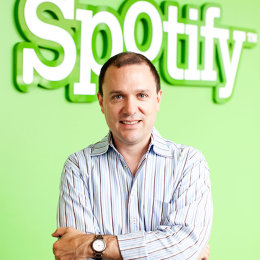Conventional wisdom holds that we're living in the era of the journalist as personal brand. Yahoo has been proudly adding household names like Katie Couric and David Pogue to its news marquee, while wonks like Nate Silver have been ditching elite print publications in favor of more entrepreneurial paths. The media executives footing the salaries and startup costs are hoping that Twitter followers migrate along with the journalists.
Amid the poaching spree, a mobile news app called Circa that eschews bylines has been steadily closing in on 1 million downloads. Today the startup announced that it will introduce native ads, as well as start licensing its data, later this year.
While social media glorifies its cults of personality, Circa favors a collaborative reporting and editing process. Circa asks you to trust its team and its product--and everything from the color scheme to the typography is designed to reinforce that trust. It's an old-fashioned approach to media branding--think The Economist--with newfangled technology humming in the background. What Circa is building is admirable--but is it what readers want?
Demand For Name-Brand News
At the other end of the news startup spectrum is Beacon, a crowdfunding platform for journalists that is part of the current Y Combinator cohort. Beacon is growing its reader base through the relationships and social media presence of its contributors.
"What we've realized is that the Beacon brand at the moment doesn't matter all that much," says Dan Fletcher, cofounder and COO. Fletcher left Facebook, where he was managing editor, to launch the site. "As a reader, you support one writer, and you experience Beacon through that lens."
In Fletcher's eyes, media is rapidly unbundling, resulting in readers who have weak ties to publications and strong ties to journalists with specialized beats. Indeed, the more focused and "expert" the pitch on Beacon, the more likely a journalist is to win over backers. "You have to have a lot of confidence and faith in these people," he says.
The Beacon framework offers journalists the rewards of independence and income, but also asks them to share in the burdens of sales and marketing. A "Worth It" button appears at the end of each article, and bonus payments are tied to readers' clicks of support.
News That's Good For You
Opening Circa for the first time made me realize how much of my media diet had become dominated by the sugar-rush junk food of one-dimensional reporting and breezy opinion. Circa stories, in contrast, are lean and almost clinical, with data-rich facts presented one after another in a progression that updates over time as events develop. "Follow" a story, and Circa sends alerts.
For the mobile reader on the go, "You can plow through a lot of key facts really quickly," says Matt Galligan, cofounder and CEO.
Moreover, for a story like the crisis in Ukraine that unfolds in fits and starts over days and weeks, Circa functions as a natural timeline that readers can enter and exit at different points without losing the overarching narrative. This "building blocks" format saves Circa stories from the identity crisis plaguing articles that morph online from wire alert to news analysis throughout the day.
"Our stories are unique to us, and the knowledge of what someone has already read is unique to us," Galligan says. With that data, and a custom-built content management system oriented around factual "objects," Circa has an engine at its disposal that can do everything from recommend articles to serve up relevant ads.
"There's a lot of interest in advertising on the platform," Galligan says. He cites advertisements in publications like Vanity Fair as his inspiration for Circa's native play: As a reader, he says, "You wouldn't want to remove the ads."
"Object-Oriented" Lends Itself To White-Labeling
For Circa, though, advertising revenue may end up playing second fiddle to licensing fees. While many news apps can deliver readers, Circa is among the first to offer an infrastructure that is endemic to digital content. In industry parlance, Circa is doing "object-oriented" journalism--and in the process, has created a platform that other publishers could leverage.
Unless you've looked under the hood at a major publication, Circa's technology may not sound so revolutionary. But if you've followed the conversation about Ezra Klein's startup at Vox Media, you'll have some idea of the direction in which media is heading, and just how hard it will be to get there.
Today, we still live in a world ruled by the traditional article--headline, byline, dateline, lede--because those are the parameters set by the technology that powers our newspapers and magazines. Straying from that format is about as easy as it would be to publish an infographic using an old-fashioned printing press.
Vox, previously dubbed Project X, aspires to create something similar to what Circa has already built for mobile: a more flexible, "atomized" technology, made up of component parts that can be remixed in countless ways. Quote, photo, chart: Naming and architecting content in this way enables opens the door to more responsive designs and smarter databases.
David Cohn, director of news for Circa, described the benefits of this approach: "The process of creating a story requires the writer to tag information in a structured way," he wrote in a Poynter article. "If we insert a quote, we have two extra fields for the name of the person quoted and an alias--their working title. As a result, I can ask our chief technology officer to search our database for all the quotes we have from, say, Eric Holder. I can also ask to have that search refined by date(s) or topics: 'Give me all the Eric Holder quotes from the last six months that are associated with the IRS.'"
Even a whiz with LexisNexis shortcuts can see the value.
Talent Follows Tech
For now, Galligan is focused on introducing these new revenue streams while continuing to grow. Circa is seeing four times the daily active users it did last September, when it first passed the half-million downloads milestone, and ratings in the App Store have remained consistently high.
Galligan hopes that the brand will stand the test of time. "I'm not a news guy. We built this because we are the users," he says.
The good news for Circa is that the savviest of the journalists with personal brands are looking for technology capabilities, not just deep pockets. Ezra Klein--and even recent hires at The New York Times--are case and point: talent follows tech. And by extension, readers will, too.





















